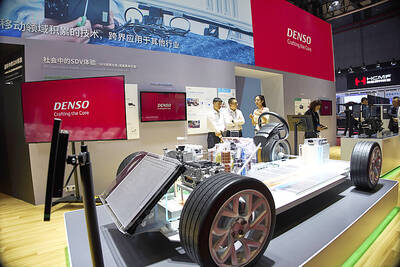Win Semiconductors Corp (Win Semi, 穩懋半導體) holds a strong outlook for the current quarter, thanks to resilient demand from smartphone and infrastructure segments.
The world’s largest compound semiconductor foundry, which is 4.72 percent owned by Avago Technologies Ltd, last week said it expects revenue to grow by a mid-single-digit percentage to a record high, compared with the NT$6.4 billion (US$209.2 million at the current exchange rate) that it made last quarter.
That would boost revenue this year by 20 percent from last year’s NT$17.31 billion, the company forecast on Friday.
“Almost all smartphone customers are showing increased demand for our products in the fourth quarter, compared with the third quarter,” Win Semi president Steven Chen (陳舜平) told investors in a teleconference.
This is a rare case for the company, which tends to see revenue peak in the third quarter of a year, Chen said.
The unusual boon comes amid strong demand for power amplifier (PA), Wi-Fi and vertical-cavity surface-emitting laser (VCSEL) chips, he said.
VCSEL chips are used in 3D face recognition applications, acting as a lighting source that provides even facial illumination with infrared light.
“That means our customers are outselling smartphones more than people had thought,” Chen said.
Gross margin for this quarter is to remain at a similar level to last quarter’s 42.1 percent, which was a historical high, he said.
Win Semi is bullish about the business outlook for next year, citing the growing demand from 5G smartphones, applications and network deployment.
“We are optimistic about next year’s outlook,” Chen said.
“There will be more 5G smartphones and applications after the [commercial] launch this year [of 5G],” he said.
“We strongly believe 5G will be a growth engine for the company in the next few years,” he added.
Win Semi, which ships PA chips for 5G-enabled phones and other products, said 5G-related chips have contributed more than 10 percent of its total revenue.
To satisfy customers’ demand for 5G chips, the company plans to expand its monthly capacity from 36,000 wafers to 41,000 wafers next year, it said.
Robust demand for smartphone-related chips — including VCSEL and Wi-Fi chips — helped boost its net profit last quarter to a historical high of NT$1.64 billion, or earnings of NT$3.9 per share, it said.
That compares with net profit of NT$384 million a year earlier and NT$1.19 billion in the previous quarter.
Gross margin improved significantly to 42.1 percent, from 34 percent in the second quarter, due to the high utilization rate of 95 percent, up from 80 percent in the previous quarter, the company said.

GROWING OWINGS: While Luxembourg and China swapped the top three spots, the US continued to be the largest exposure for Taiwan for the 41st consecutive quarter The US remained the largest debtor nation to Taiwan’s banking sector for the 41st consecutive quarter at the end of September, after local banks’ exposure to the US market rose more than 2 percent from three months earlier, the central bank said. Exposure to the US increased to US$198.896 billion, up US$4.026 billion, or 2.07 percent, from US$194.87 billion in the previous quarter, data released by the central bank showed on Friday. Of the increase, about US$1.4 billion came from banks’ investments in securitized products and interbank loans in the US, while another US$2.6 billion stemmed from trust assets, including mutual funds,

AI TALENT: No financial details were released about the deal, in which top Groq executives, including its CEO, would join Nvidia to help advance the technology Nvidia Corp has agreed to a licensing deal with artificial intelligence (AI) start-up Groq, furthering its investments in companies connected to the AI boom and gaining the right to add a new type of technology to its products. The world’s largest publicly traded company has paid for the right to use Groq’s technology and is to integrate its chip design into future products. Some of the start-up’s executives are leaving to join Nvidia to help with that effort, the companies said. Groq would continue as an independent company with a new chief executive, it said on Wednesday in a post on its Web

Even as the US is embarked on a bitter rivalry with China over the deployment of artificial intelligence (AI), Chinese technology is quietly making inroads into the US market. Despite considerable geopolitical tensions, Chinese open-source AI models are winning over a growing number of programmers and companies in the US. These are different from the closed generative AI models that have become household names — ChatGPT-maker OpenAI or Google’s Gemini — whose inner workings are fiercely protected. In contrast, “open” models offered by many Chinese rivals, from Alibaba (阿里巴巴) to DeepSeek (深度求索), allow programmers to customize parts of the software to suit their

JOINT EFFORTS: MediaTek would partner with Denso to develop custom chips to support the car-part specialist company’s driver-assist systems in an expanding market MediaTek Inc (聯發科), the world’s largest mobile phone chip designer, yesterday said it is working closely with Japan’s Denso Corp to build a custom automotive system-on-chip (SoC) solution tailored for advanced driver-assistance systems and cockpit systems, adding another customer to its new application-specific IC (ASIC) business. This effort merges Denso’s automotive-grade safety expertise and deep vehicle integration with MediaTek’s technologies cultivated through the development of Media- Tek’s Dimensity AX, leveraging efficient, high-performance SoCs and artificial intelligence (AI) capabilities to offer a scalable, production-ready platform for next-generation driver assistance, the company said in a statement yesterday. “Through this collaboration, we are bringing two